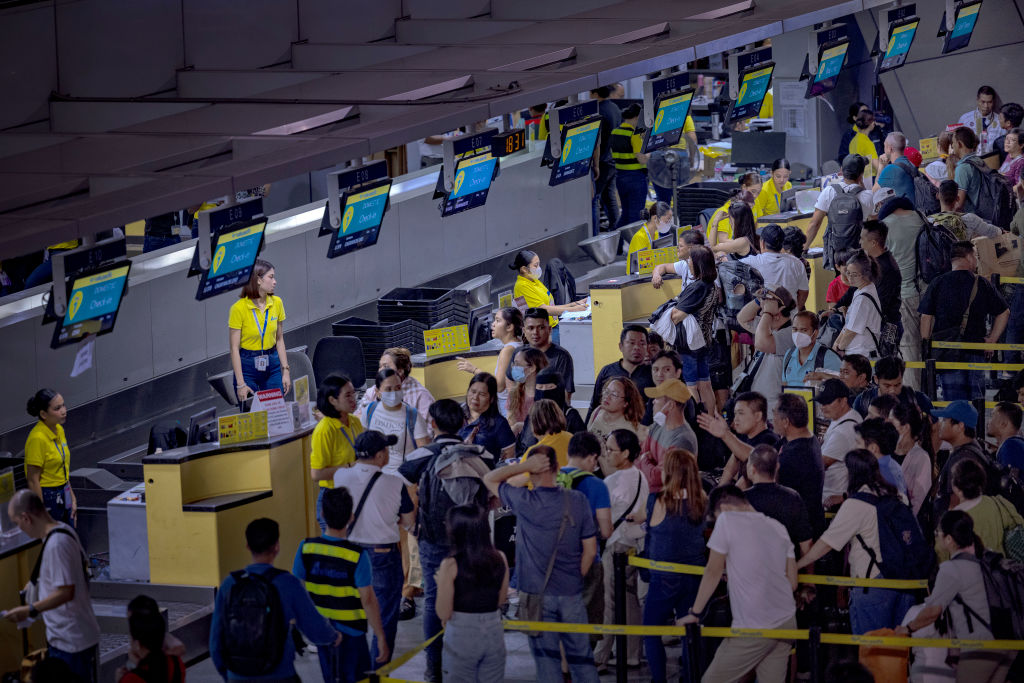
Long queues of passengers form at the check-in counters at Ninoy Aquino International Airport, amid a global IT disruption caused by a Microsoft outage and a Crowdstrike IT problem, on July 19, 2024 in Manila, Philippines. A significant Microsoft outage impacted users globally, leading to widespread disruptions, including cancelled flights and disruptions at retailers globally. Airlines like American Airlines and Southwest Airlines reported difficulties with their systems, which rely on Microsoft services for operations. The outage affected check-in processes and other essential functions, causing frustration among travellers and lines to back up at many affected airports worldwide (Ezra Acayan/Getty Images).
Air travel, banking, media and hospital systems are just some of the industries affected by a bug in a software update that has scrambled business operations for many globally Friday morning.
Many of those who use Microsoft Windows are likely experiencing a “blue screen of death” or an error page. The issue is due to a single bug in a software update from cybersecurity company CrowdStrike, which provides antivirus software for Microsoft users.
The company pushed out an update to the software overnight, and at 1:30 a.m. EST, CrowdStrike said its “Falcon Sensor” software was causing Microsoft Windows to crash and display a blue screen, Reuters reported.
CrowdStrike President and CEO George Kurtz released a statement early Friday morning on X, saying that the incident was not a security concern or a cyberattack. He added that the issue has been identified and that the company has been deploying a fix.
“We refer customers to the support portal for the latest updates and will continue to provide complete and continuous updates on our website,” Kurtz said.
The bug was causing major delays and cancellations at airports across the globe. Flight tracking data site FlightAware noted nearly 24,000 delays and 2,300 cancellations globally by 9:30 a.m. Friday. While some airlines have been able to resume operation of their digital systems, others are finding analogue solutions in the meantime.
The U.S. Department of Transportation said it was monitoring the situation and suggested those experiencing travel delays and cancellations to use its FlightRights.gov website to help navigate their delays in travel.
Some states’ 911 and non-emergency lines were experiencing issues, including Alaska, Virginia and New Jersey.
New Jersey Governor Phil Murphy released a statement early Friday morning saying that the state had activated its State Emergency Operations Center in response to the disruptions and has provided guidance to other agencies about how to work through the situation.
“We are also engaging county and local governments, 911 call centers, and utilities to assess the impact and offer our assistance.,” he said.
Microsoft released a trouble shooting guide on X early Friday morning.
By 10 a.m. Friday, some global companies were seeing relief in their outages. Downdetector, which tracks real-time outages, showed companies like Visa, Zoom, UPS and Southwest Airlines gaining more normal operations than they were experiencing in the early morning hours.
Speaking to the hosts of Today this morning, Kurtz said he was “deeply sorry for the impact we’ve caused to customers, to travelers, to anyone affected.” He said some customers have been able to reboot and are seeing progress getting online, and that trend will likely continue throughout the day.
(This is a developing story)
Our stories may be republished online or in print under Creative Commons license CC BY-NC-ND 4.0. We ask that you edit only for style or to shorten, provide proper attribution and link to our website. AP and Getty images may not be republished. Please see our republishing guidelines for use of any other photos and graphics.




